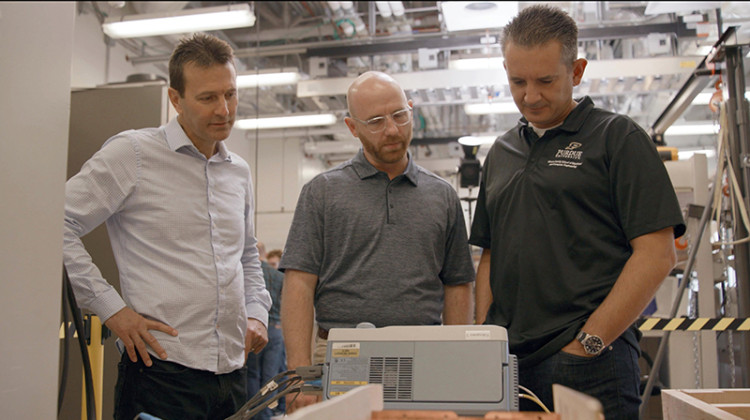Purdue, INDOT to test new highway that can charge electric vehicles
Purdue, INDOT to test new highway that can charge electric vehicles WFYI



Aaron Brovont (middle) and other engineers seen in a lab surveying technology that can charge electric vehicles.
Courtesy of Purdue University
Construction Begins on Electric Vehicle Charging Highway Segment
Purdue University and the Indiana Department of Transportation will commence construction this week on a segment of highway capable of charging electric semi-trucks as they drive over it.
Transforming Highways for Sustainable Development
This first-of-a-kind project has the potential to transform highways across the country, aligning with the Sustainable Development Goals (SDGs) set by the United Nations.
Wireless Charging Technology
The construction work will focus on a quarter-mile segment of roadway just outside of West Lafayette. This innovative infrastructure will enable batteries for electric semi-trucks to charge as they pass over it, similar to a wireless phone charger.
Uninterrupted Travel and Reduced Emissions
Purdue Research Assistant Professor Aaron Brovont explains that the charging system will be powerful enough to charge electric cars and maintain the battery charge of heavy-duty electric vehicles. This means that these vehicles would not need to stop and recharge, allowing for uninterrupted travel across the country.
By implementing this system on highways nationwide, it could address concerns about range anxiety associated with electric vehicles and contribute to the reduction of emissions, supporting SDG 7 (Affordable and Clean Energy) and SDG 13 (Climate Action).
Feasibility of Electric Semi-Trucks
The introduction of these new highways could also make electric semi-trucks more feasible. Currently, these trucks require large batteries, which limit their practicality. However, with the implementation of the charging system, the size of the batteries can be reduced, making electric trucks economically competitive with diesel vehicles. This supports SDG 9 (Industry, Innovation, and Infrastructure) and SDG 11 (Sustainable Cities and Communities).
Testing and Future Plans
Researchers anticipate that testing of the quarter-mile strip of roadway will commence next year. This project showcases the potential for sustainable transportation infrastructure and its contribution to achieving the SDGs.
SDGs, Targets, and Indicators
| SDGs | Targets | Indicators |
|---|---|---|
| SDG 7: Affordable and Clean Energy | 7.3: By 2030, double the global rate of improvement in energy efficiency | Not mentioned in the article |
| SDG 9: Industry, Innovation, and Infrastructure | 9.1: Develop quality, reliable, sustainable, and resilient infrastructure | Not mentioned in the article |
| SDG 11: Sustainable Cities and Communities | 11.2: By 2030, provide access to safe, affordable, accessible, and sustainable transport systems for all | Not mentioned in the article |
| SDG 13: Climate Action | 13.2: Integrate climate change measures into national policies, strategies, and planning | Not mentioned in the article |
| SDG 17: Partnerships for the Goals | 17.17: Encourage and promote effective public, public-private, and civil society partnerships | Not mentioned in the article |
1. Which SDGs are addressed or connected to the issues highlighted in the article?
The SDGs that are connected to the issues highlighted in the article are SDG 7: Affordable and Clean Energy, SDG 9: Industry, Innovation, and Infrastructure, SDG 11: Sustainable Cities and Communities, SDG 13: Climate Action, and SDG 17: Partnerships for the Goals.
2. What specific targets under those SDGs can be identified based on the article’s content?
Based on the article’s content, the specific targets that can be identified are:
– Target 7.3: By 2030, double the global rate of improvement in energy efficiency.
– Target 9.1: Develop quality, reliable, sustainable, and resilient infrastructure.
– Target 11.2: By 2030, provide access to safe, affordable, accessible, and sustainable transport systems for all.
– Target 13.2: Integrate climate change measures into national policies, strategies, and planning.
– Target 17.17: Encourage and promote effective public, public-private, and civil society partnerships.
3. Are there any indicators mentioned or implied in the article that can be used to measure progress towards the identified targets?
No indicators are mentioned or implied in the article that can be used to measure progress towards the identified targets.
Behold! This splendid article springs forth from the wellspring of knowledge, shaped by a wondrous proprietary AI technology that delved into a vast ocean of data, illuminating the path towards the Sustainable Development Goals. Remember that all rights are reserved by SDG Investors LLC, empowering us to champion progress together.
Source: wfyi.org

Join us, as fellow seekers of change, on a transformative journey at https://sdgtalks.ai/welcome, where you can become a member and actively contribute to shaping a brighter future.








